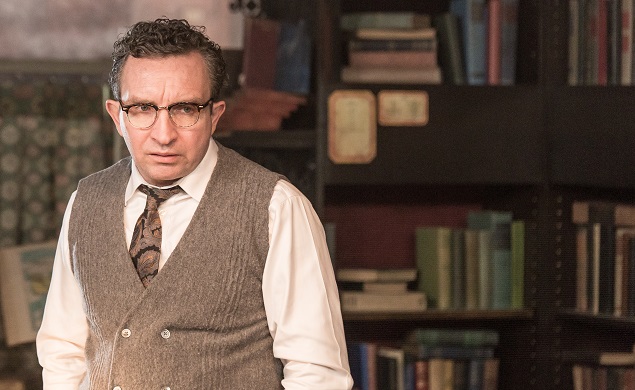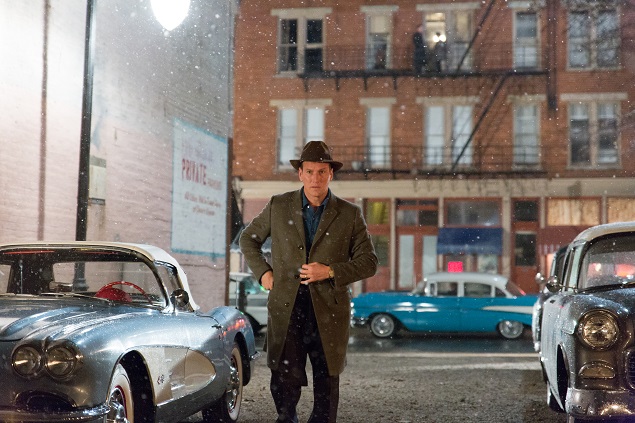Tribeca Reviews: The Ambiguity of Murder

Jessica Biel as Clara Stackhouse and Patrick Wilson as Walter Stackhouse in Andy Goddard’s A Kind of Murder. Photo Credit: Brian Douglas, Copyright © 2015 Blunderer Holdings, LLC.
“There’s a difference between wishing someone dead and doing something about it.” At least that’s what architect Walter Stackhouse believes in A Kind of Murder, a feature film that recently premiered at The Tribeca Film Festival. But is there — a difference? Based on Patricia Highsmith’s novel, The Blunderer, this is just the kind of murky moral territory this writer (Strangers on a Train, The Talented Mr. Ripley, and most recently, Carol) is famous for. Don’t look for the good guy because there isn’t one.
On the surface, Walter and his wife, Clara, seem to embody the perfect 1960s lifestyle. They live in a perfectly-manicured home in New York City’s suburbs, designed by Walter without a single ashtray out of place. As portrayed by Patrick Wilson, the character embodies the kind of casual sophistication viewers may remember in the young Paul Newman, from his cardigan sweater to the cut of his jaw. As for Clara (Jessica Biel), she is the embodiment of the sleekly-coifed wife we expect as the counterpart to such a man. Such appearances, however, are not to remain flawless for long.
On the other side of the Hudson River, a New Jersey antiquarian book dealer is up to some sinister doings in his own domestic relationship. British character actor Eddie Marsan as the pasty-faced Mr. Kimmel could step out of his dark and dusty warren into the shoes of any Dickensian evil-doer without missing a beat. If we were still unclear about his murderous intents, film composers Danny Bensi and Saunder Jurriaans provide just the right undercurrent of dread as accompaniment.
Meanwhile, back at the sumptuous digs where the Stackhouses are playing house, Clara is coming unhinged in short order. Burdened by worries about a sick mother upstate and too much amorous attentiveness from her spouse, she is on the verge of a full-blown nervous breakdown. The way screenwriter Susan Boyd has interpreted the character and Highsmith has created her, Clara is one of the most unlikeable, if not villainous, ’50s-style leading ladies to fill a movie screen. Whatever touches of vulnerability she exhibits, and actress Jessica Biel attempts to give her, it quickly becomes obvious why Walter would “have this fantasy that she’s no longer there.”
The latent but growing hostility Walter harbors against his wife fuels his own natural curiosity about criminal goings-on in general. When he’s no longer welcome in the conjugal bed, he finds solace in the crime stories he fashions in his study. In fact, he’s got a whole album of clippings on murderous events, so it’s no wonder that reading about the murder of Kimmel’s wife inspires him to investigate the man under suspicion in person.
As Walter’s natural curiosity becomes obsession, the plot quickly thickens. Enter Lawrence Corby, an equally obsessive detective whose scent for wrongdoing is further enhanced by Walter’s own almost perverse curiosity about the same crime. The film then becomes a cat and mouse triangle that holds the viewer on the edge of his or her seat. Vincent Kartheiser, a seven-season veteran of Mad Men, in the role of the alternately wired and moody Pete Campbell, may seem at first a strange casting choice for the typical gumshoe. But he brings an atypical wired energy to the role. With a ’50s crew cut to boot, he adapts quite nicely to director Andy Goddard’s cinematic vision.

Eddie Marsan as Kimmel in Andy Goddard’s A Kind of Murder. Photo Credit: Brian Douglas, Copyright © 2015 Blunderer Holdings, LLC.

Patrick Wilson as Walter Stackhouse in Andy Goddard’s A Kind of Murder. Photo Credit: Brian Douglas, Copyright © 2015 Blunderer Holdings, LLC.
Adopting the nourish undertones that come so naturally to Highsmith, the screen adaptation introduces a flirtation between Walter and Ellie Briess, a hip young Village songstress. When his relationship goes south with Clara, he turns up the heat with Ellie. She’s everything to Walter that Clara is not. Thanks to the casting of Haley Bennett, we get a truly talented young actress who not only can smolder and keep her distance at the same time, but suggests with her singing voice a young Julie London.
With this film, Goddard is fast stepping into the shoes of such erstwhile directors as Douglas Sirk (Portrait in Black, Imitation of Life), a ’50s artisan who knew how to dress a set with immaculate precision. Another master at perfecting a “look” was the German cult icon Rainer Werner Fassbinder from the ’70s. Some mention should be made of producer Christine Vachon, who with partner Pamela Koffler co-founded Killer Films in 1995. Their interest in period stories with issues of social conflict at play was evident in Carol and Far from Heaven. Both of those films were nominated for multiple Academy Awards.
There can be a risk in the balancing act between style and substance. To achieve the perfect marriage between these two elements is a rare gift. There’s no question that director Goddard met that challenge in his debut film, Set Fire to the Stars. In that film, a young poetry professor, played with wide-eyed innocence by Elijah Wood, sets out to bring the brilliant and drunken poet Dylan Thomas to America for a national tour. Shot in black and white and filled with a hypnotic cast of eccentric supporting players, it’s a master class in style and substance.
In A Kind of Murder, Goddard has performed another high wire act. The only criticism could be that the minutia of costume detail, the lighting of a cigarette, the often stunning visual presented to us can detract from the deeper purpose of the scene at hand. At other times, the repetition of red — i.e. in Clara’s dress, or the Chinese red lamps of the period, for instance — is quite an effective touch. The pervasiveness of falling snow brings an added chill to the sinister proceedings as well.
Andy Goddard has obviously done his homework for a doctoral thesis on film, and any smart filmgoer will keep an eye out for his next offering.
Rating: A-
The 96-minute feature, “A Kind of Murder,” had its world premiere at the 2016 Tribeca Film Festival.
